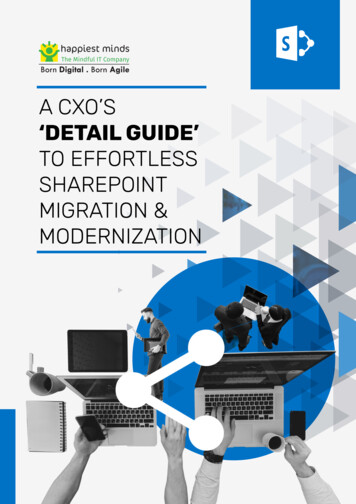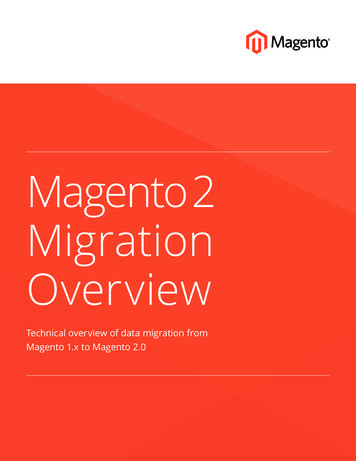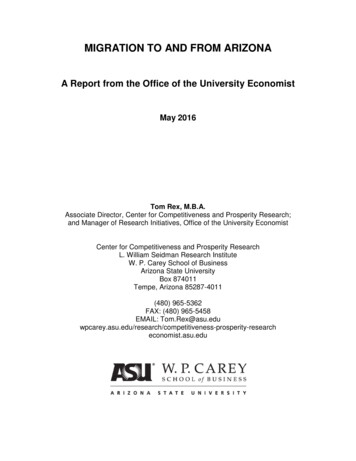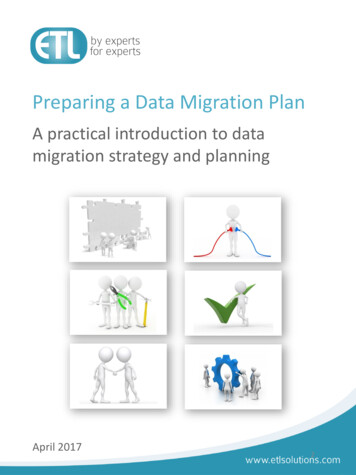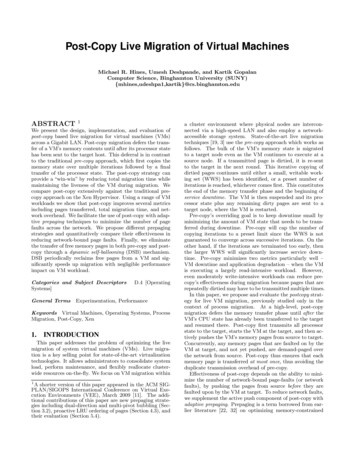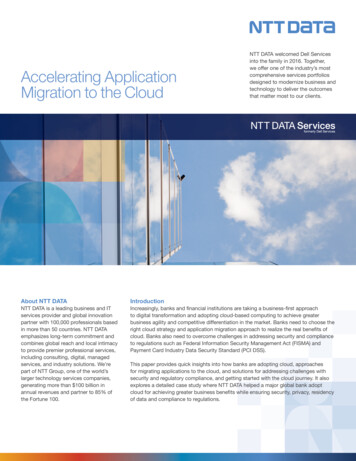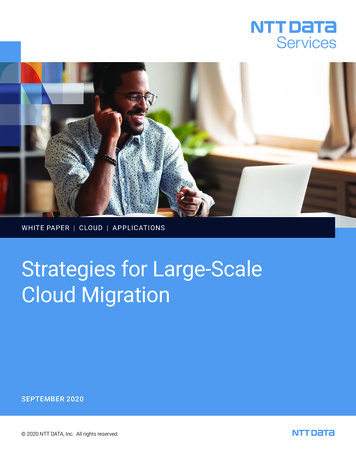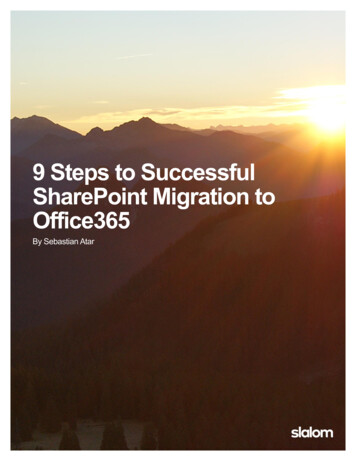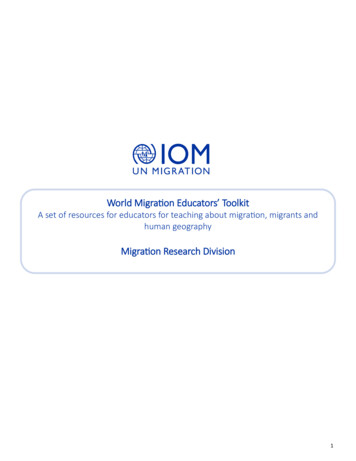
Transcription
World Migration Educators’ ToolkitA set of resources for educators for teaching about migration, migrants andhuman geographyMigration Research Division1
IntroductionThe Toolkit draws upon the extensive research and analysis in the World Migration Report series todeliver specialized tools and resources for use by key audiences, such as educators. The World Migration Report is the flagship publication series of the International Organization for Migration, the UnitedNations migration agency. The report presents data and information on human migration togetherwith analysis of complex and emerging migration issues. It has been in production for more than twodecades. Because of it’s global focus, the Toolkit uses content from around the world to support learning on this global issue. Just like the Report itself, this Toolkit has been peer reviewed by educationand migration experts to ensure it meets the highest quality standards.Through the Toolkit classrooms will be able to engage critically on crucial themes related to populationmovement, demographic change and the drivers of migration, displacement and mobility. Divided intoseven modules, the Educators’ Toolkit addresses some of the foundational questions in migrationstudies, but in a format that is accessible for a secondary-level human geography course. The modulesprovide instructors with the option to utilize the entire Toolkit, but also the flexibility to draw uponcertain resources that best suit the course design and classroom of their school. Each module focuseson a specific aspect of migration, as follows: What is migration? Who migrates? Why do people migrate? Where do people migrate? How do people migrate? When do people migrate? Implications of migration.Within each module, the educator will find a set of resources which can be applied within the classroom to spur student learning on the topic. These include:Resource guides—Two page briefs which compile the research and analysis on the topic and provide some starter questions to check for understanding and begin discussion. An excellent starterpiece for a lesson.Case studies—In-depth studies of migration topics for extending student thinking. Divided intoText case studies and Data case studies, these allow the student to see how concepts are appliedin specific regional contexts.Interactive Scenarios—The core of the curriculum, these interactive activities allow students to engage in migration concepts in a role-playing situation based on a real world scenario.While the World Migration Report is the primary source document for much of the research and analysis presented in this curriculum, educators will find that students will also be encouraged to accessother primary source documents to inform their learning.We hope that this Educators’ Toolkit will be of great use to you and your students. For more information, you can access the World Migration Report here and view the data visualization of the reporthere. More information about work can be found here. You can contact us via research@iom.int.2
Table of ContentsI. Module 1: What is Migration?A. Instructional guideB. Resource guideC. Text-case study: How is migration is measured?D. Data case study: Missing Migrants Project; International studentsE. Interactive scenario: New Features for a Language AppII. Module 2: Who migrates?A. Instructional guideB. Resource guideC. Text-case study: Gender disparities in migrationD. Data case study: Changing demographics of migrants; Children and migrationE. Interactive scenario: City council hearing on the drivers of migrationIII. Module 3: Why do people migrate?A. Instructional guideB. Resource guideC. Text-case study: Migration driversD. Data case study: International and internal displacementE. Interactive scenario: Internal Displacement Monitoring CenterIV. Module 4: Where do people migrate?A. Instructional guideB. Resource guideC. Text-case study: Extraregional migration changes over timeD. Data case study: Intraregional migration by the numbersE. Interactive scenario: UNDAC disaster preparedness activity3
Table of Contents, continuedV. Module 5: How do people migrate?A. Instructional guideB. Resource guideC. Text-case study: The appification of migrationD. Data case study: International travel in the age of the pandemicE. Interactive scenario: The Henley Visa IndexVI. Module 6. When do people migrate?A. Instructional guideB. Resource guideC. Text-case study: Environmental drivers to migrationD. Data case study: Seasonal migration analysisE. Interactive scenario: Bilateral and multilateral negotiation for migrant labor agreementsVII. Module 7. Implications of MigrationA. Instructional guideB. Resource guideC. Text-case study: U.N. official statements on migration; Migration in the mediaD. Data case study: Migration and remittancesE. Interactive scenario: Contributions of migrantsVIII. End-of-unit interactive activityA. Scenario: High-Level Country Report to the UN-ECOSOC Humanitarian Affairs SegmentIX. Glossary4
Module 1What is Migration?5
of ContentsModule 1: What is TableMigration?— Instructional GuideIntroduction to Module: Migration is defined as the movement of persons away from their placeI.Module1: Whateitheris Migration?of usualresidence,across an international border or within a country. Module 1 will introA.Instructionalguideduce students to definitions of migration and introduce some of the broad ideas and conceptsB. Resourceguideassociatedwith globalmigration, including: population change, migration flows, types of migraC. categoriesText-case study:How is migration more difficult to measure than birth/death?tion, andof migrants.D. Data case study: International students, tourism, and other ‘grey-areas’ in migrationLearningbe ableto defineappmigration,differentiateinternationalE. Objective:InteractiveStudentsScenario:willHelpinga languagecreate newfeatures betweenfor migrants.migrationand internationalmigration, and learn about migration inflows and outflows.F. Evidenceof learningG. Answerkey Thisand rubricsWMR ChapterFocus:module will draw on Chapters 2 and 3 of the World Migration Report.II. Module 2: Why do people migrate?ProposedSchedule: 1-2guideclass periods (50-100 minutes) plus independent student work.A. InstructionalB. Resource Classguideperiod one: introduction, student resource sheet; text-based and data-basedC. Text-casestudy: Migration driversquestionsD. Data case study: Refugee hosting and asylum seeking among African countries Class period two: Module One Scenario Interactive Activity: “New Features for aE. Interactive Scenario: City Council Hearing on the drivers of migration.Language App”F. Evidence of learningStudentG.Assessment:are several assessment options in this module and teachers may useAnswer key Thereand rubricssomeor all ofIII. Module3: them.Who are migrants?A.Instructional theguideUnderstandingBasics:B. Resource guide Questionsthe StudentResource SheetsC. Text-casestudy: basedGenderondisparitiesin migrationD. DataFurther:case study: Changing demographics of migrants.GoingE. Interactive Scenario: Social, cultural, political, and economic contributions of migrants. Text case study: How is migration more difficult to measure than birth/death?F. Evidence of learning DataG. Answerkeycaseandstudy:rubrics Focus on the Missing Migrants Project and the issue of internationalstudentsan example of migration.IV. Module 4: Wher do people asmigrate?A. Instructionalguide InteractiveScenario: Students work with language app 'Duolingo' to create newB. Resourceguidefeatures that target migrants and people working migrant populations. Play theC. Text-casemigrationchangesover timevideostudy:here Extraregionalas an introductionto learninglanguageapps.D. Data case study: Intraregional migration by the numbers.EvidenceLearning:Scenario:Students will work together to complete a group activity that focuses on theE. ofInteractivemovementof peopleF. Evidenceof aroundlearningthe world. The activity includes an oral presentation and a writtenreflectionontheproject.G. Answer key andDetailsrubricsof the Evidence of Learning assessment is found in the 'Scenario'sectionof theV. Module5: module.How do people migrate?InstructionalguideStarter A.Activity:Introducestudents to the definition of migration by asking why they know aboutB.Resourceguidethe issue. Lead the class in a discussion of some of the key definitions surrounding the issue of miText-casestudy:gration C.(seeGlossary).Ask Smugglingif studentsandcan irregularguess or migrationidentify some of the reasons why people miD. Datastudy:numberspretoandpost COVID-19.grate. Findout ifcasetheyknowMobilitywhere peopletendmigratefrom and where they tend to migrateE.InteractiveScenarioto.F. Evidence of learningInteractive Visualization: Visit the World Migration Interactive to learn more about key data andG. Answer key and rubricsinformation on migration.6
Resource Guide Module 1: What is Migration?Module #1 Learning Objective: Students will be able to define migration, differentiate between international migration and internal migration, and learn about migration inflows and outflows.What is migration?Migration is the movement of persons away from their place of usual residence, either acrossan international border or within a State, to a new residence. Migration has emerged in thelast few years as a critical political and policy challenge in matters such as integration, displacement, safe migration and border management. Module 1 introduces students to themigration cycle, population change and human mobility.The Migration CycleReturnSome migrants return to theirhome country (international migrants) or their home district/state (internal migrants).In some situations, migrants donot return but remain in their newcountry/district for the rest oftheir lives. They may even migrateto yet another place.StayThis part of the migration cycleinvolves migrants living in theirnew location (e.g. country or district). Some may be able to integrate into theirnew communities, and some international migrants may even eventually become citizens oftheir new country.Pre-departureThe period before the migrationjourney commences. Typicallyinvolves decision making andorganisation.EntryProcesses related to the entry ofmigrants into another country ordistrict. Crossing international borders usually involves passing througha border point; internal migrationwithin a country does not usuallyinvolve passing through a borderpoint.Source: World Migration Report 2022 (forthcoming).Key termsKey resources on the topicMigrationWorld Migration Report 2020, Chapter 2Migration CycleIOM Glossary of Key TermsInternational MigrationInternal Migration7
Internal and international ‘migration’For demographic purposes, migration can be classified into two broad types: international and internalmigration. In a general sense, 'migration' is the process of moving from one place to another. To migrateis to move, whether from a rural area to a city, from one district or province in a given country to anotherin that same country, or from one country to a new country. It involves action. International migrationoccurs when people cross state boundaries and stay in the host state for some minimum length of time.When people move within a country it is called internal migration. Migration from rural areas to urbanlocations within a country is called ‘urbanization’.Difficulty of obtaining migration flow dataCapturing data on migration flows isextremely challenging for several reasons. For instance, while internationalmigration flows are generally acceptedas covering inflows (flows of migrantsentering into a particular boundary)and outflows (flows of migrants leaving a particular boundary) into andfrom countries, there has been agreater focus on recording inflows.Source: World Migration Report 2020, Chapter 2, Page 31For example, while countries such as Australia and the United States count cross-border movements, many others only count entries and not departures. Additionally, migration flow data insome countries are derived from administrative events related to immigration status (for example,issuance/renewal/withdrawal of a residence permit) and are thus used as a proxy for migrationflows. Furthermore, migratory movements are often hard to separate from non-migratory travel,such as tourism or business. Tracking migratory movements also requires considerable resources,infrastructure and IT/knowledge systems. This poses particular challenges for developing countries,where the ability to collect, administer, analyse and report data on mobility, migration and otherareas is often limited. Finally, many countries’ physical geographies pose tremendous challenges forcollecting data on migration flows.Reflection questions1. Explain the difference between ‘international migration’ and ‘internal migration.’2. During the “migration cycle”, do all migrants pass through a border point on entry? Please explainyour answer and provide examples.3. Briefly explain two reasons why obtaining migration flow data can be difficult.8
Module 1: What is migration?Text case studyBelow is a short text drawn from Chapter 2 of the World Migration Report. Review it and answerthe questions below.Introduction to Migration Human migration is an age-old phenomenon that stretches back to the earliest periods of humanhistory. Migration is the movement of persons away from their place of usual residence, eitheracross an international border or within a State In the modern era, emigration and immigrationcontinue to provide States, societies and migrants with many opportunities. At the same time, migration has emerged in the last few years as a critical political and policychallenge in matters such as integration, displacement, safe migration and border management. In most discussions on migration, the starting point is usually numbers. Understanding changes inscale, emerging trends and shifting demographics related to global social and economic transformations, such as migration, help us make sense of the changing world we live in and plan for thefuture. The current global estimate is that there were around 281 million international migrants inthe world in 2020, which equates to 3.6 per cent of the global population. A first important point to note is that this is a very small minority of the world’s population,meaning that staying within one’s country of birth overwhelmingly remains the norm. The greatmajority of people do not migrate across borders; much larger numbers migrate within countries(an estimated 740 million internal migrants in 2009). That said, the increase in international migrants has been evident over time – both numerically and proportionally – and at a slightly fasterrate than previously anticipated.1. Why is it important to understand ‘scale’ when thinking about the issue of migration?2. Based on your reading of this passage and the information from the previous section, what can youinfer about the challenge of international migration in the future?9
Read the selection below and answer the questions about migration and population change in Africa.Migration and population change in AfricaMany African countries have experienced significant changes in the size of their populations inrecent years, as shown in figure 2, which ranks the top 20 African countries with the largest proportional population change between 2009 and 2019. All top 20 countries were in sub-SaharanAfrica and each underwent substantial population growth during this period. These 20 countriesreflect the trend across the continent, with Africa currently the fastest-growing region in theworld and expected to surpass 2 billion people by 2050. It is important to note that the largestproportional population changes from 2009 to 2019 occurred in countries with relatively smallerpopulations, as to be expected. Africa’s most populous countries – Nigeria, Ethiopia and Egypt –are not among the top 20; however, all three countries also experienced increases in their populations. The population growth in Africa is in contrast to population change in Europe, for example,which has experienced slower population increases in some countries and even decline in othersover the same period.The significant increase in international migration within Africa has contributed to the recent population growth at the national level. While migration is not the only factor, with high fertility ratesand increasing life expectancy also playing roles, increased intraregional migration within the continent has influenced population changes in some countries. For example, the share of international migrants as a proportion of national population in Equatorial Guinea has sharply increasedin recent years. In 2005, international migrants accounted for less than 1 per cent of EquatorialGuinea’s population; by 2019, this figure had increased to nearly 17 per cent.Source: WMR 2020,p. 55-5610
3. The selection uses the example of Equatorial Guinea to make a point about populationchange. What does the text suggest may be a major contributing factor to Equatorial Guinea’spopulation growth?4. The author of this selection compares the population change of Africa with that of Europe.What is the major difference highlighted in the text?11
Module 1: What is migration?Data case studyPart I. Missing MigrantsThe IOM’s Missing Migrants Project tracks incidents involving migrants, including refugees andasylum-seekers, who have died or gone missing in the process of migration towards an international destination. Visit the Missing Migrant Project page at https://missingmigrants.iom.int/ anduse the information from the page to answer the questions below.1. According to the site’s main page, how many migrant fatalities have occurred so far this calendar year?2. What are the top 3 regions where migrant fatalities have occurred so far this year?3. Fill in the chart below with the appropriate information from the Missing Migrant Projectwebpage (you will need to scroll down the main page to find some information).RegionRecorded migrantdeaths in 2014Recorded migrantdeaths in 2017Recorded migrantdeaths in 2020AfricaAsiaEuropeLatin America and CaribbeanNorthern AmericaOceania12
Module 1: What is migration?Data case studyPart II. International StudentsAn estimated 5.3 million students undertook international migration to study abroad in 2017 according to UNESCO. Most academic programs last around 10 months, with the United States, Germany, and Australia as three of the most popular destination countries for international students,at least before the COVID-19 pandemic.1. Using UNESCO’s Global Flow of Tertiary-Level Students visualization, toggle to a country andclick “Where do students come from.” Draw a stacked vertical bar chart showing the top 5 origincountries for each international student destination. The first country has been done for you asan example. Origin countries for each destination may differ.13
2. For those same countries, what were the 3 most popular destinations for international students? What might explain why students wanted to study in those destinations?"3. How does international academic study fit the definition of migration? How might it not?14
Module 1: What is migration?Interactive ScenarioDuolingo, a language learning app, wants to supplement its features with language assistancefeatures specifically targeted for international migrants from Africa and Asia. It has tasked acommittee to determine where the largest corridors of migration flows occur, and what languages changes the app designers should be aware of as they develop this new feature.Instructions: Divide into teams of 4-5 people. Using Chapter 3 of the World Migration Report, research the main migration statistics and trends as it relates to where migrants are coming fromand going to. Teams should use information from the entire chapter but may find it useful to payparticular attention to Figures 1, 3, 4, 9, and 10. An interactive visualization of information thatmay be helpful can be found at the WMR interactive site.Prepare a presentation for the Duolingo app designers to help determine where they shouldspend their budget. The presentation should be divided into two parts and should focus on theinformation below. Each team may include more information and details as needed:Part I. Statistics What are the largest destination countries for international migrants for each region? What are the largest origin countries for international migrants for each region? Explain some of the broad trends where people are moving within each the region.Part II. Language trends Where are people moving? What languages might they need to learn upon emigrating? What migration transition countries might be used by people on the move? What languagesmight be helpful in those countries? Do we already have the languages? How should we change, increase or expand the languagecapabilities of what we provide on our app?Part III. Conclusions What are the three (3) most important additional features that should be added to the Duolingo app to help the needs of migrants? Justify your answers.Part IV. Written Activity Write a paragraph justifying the conclusions of your team. Each team member should writetheir own paragraphs.15
Module 2Who migrates?16
Table of ContentsModule 2: Who Migrates?—Instructional GuideIntroduction to Module: In this module students will learn about who migrates and what kinds ofI. Module 1: What is Migration?contributions migrants make to local communities in both origin countries and destination counA. Instructional guidetries.B. Resource guideLearningStudentswillable to morespecifythe broadpatternsthanof whomigrates, includingC. Objective:Text-case study:Howis bemigrationdifficultto measurebirth/death?migrantD.populationby nationality,gender,age, andoccupationalbackData case trendsstudy: broken-downInternational students,tourism,and other‘grey-areas’in migrationground.E. Interactive Scenario: Helping a language app create new features for migrants.F. Evidenceof learningWMR ChapterFocus:This module draws on Chapters 5 and 6 of the 2020 World Migration ReportG. Answer key and rubricsProposed2 50-minutelessons.II.ModuleSchedule:2: Why dopeople migrate?A. Instructionalguide Lesson 1:Introduction on material; Student Resource Sheet and Questions; TableB. Resourceguideand Chart Case StudyC. Text-case study: Migration drivers Lesson 2: Text-base Case Study; Interactive ScenarioD. Data case study: Refugee hosting and asylum seeking among African countriesStudentE.Assessment:There areCityseveralassessmentoptionsin thisofmoduleand teacher may useInteractive Scenario:CouncilHearing onthe driversmigration.some orF.allof them.of learningEvidenceG. Answer keyrubricsUnderstandingtheandBasics:III. Module 3: Who are migrants? Questionsbased on the Student Resource SheetsA. InstructionalguideB. ResourceGoingFurther: guideC. Text-case study: Gender disparities in migration Text case study: Migrant issues related to womenD. Data case study: Changing demographics of migrants. Data casestudy:Social,Demographicrelatedto migrantsin the CaribbeanandE. InteractiveScenario:cultural,issuespolitical,and economiccontributionsof migrants.LatinofAmerica;F. EvidencelearningMigration and ChildrenG. Answerkey and rubrics Interactive Scenario: Parliament Committees to exploring how migrants contributeIV. Module 4: Wherpeople migrate?to thedosocial-cultural,civic-political, and economy of a countryA. Instructional guide EvidenceB. Resourceguideof Learning: An Evidence of Learning activity is included at the end of themoduleC. Text-casestudy: Extraregional migration changes over timeD.Datacasestudy:Intraregionalmigrationby Globalthe numbers.Starter Activity: Spendtimegoing over theIOM KeyMigration Figures graphic. Ask stuE.InteractiveScenario:dents if any of the data presented is surprising. Research a famous person who was a migrantF. Evidenceof learning(examples:MadeleineAlbright, Wycliff Jean, Yusra Mardini or examples m)and talk to the class about their story and how they contributed toV.Module5:Howdopeoplemigrate?society after leaving their country of origin.A. Instructional guideB. Resource guideInteractive Visualization: Go to www.storiesbehindaline.com and view the interactive migrantC. Text-case study: Smuggling and irregular migrationstories with your students. You can pick 2 or 3 to highlight.D. Data case study: Mobility numbers pre and post COVID-19.E. Interactive ScenarioF. Evidence of learningG. Answer key and rubrics17
Resource Guide Module 2: Who migrates?Module #2 Learning Objective: Students will be able to specify the broad patterns of who migrates, including migrant population trends broken-down by nationality, gender, age, and occupational background.Snapshot of international migrantsWho migrates?The current global estimate is that there werearound 272 million international migrants in theworld in 2019, whichequates to 3.5 per cent ofthe global population. Aswill be further explored inthis module, the overwhelming majority of people migrate internationallyfor reasons related towork, family and study –Source: WMR 2020, page 22.involving migration processes that largely occur without fundamentally challenging migrants themselves or the countries theyenter. In contrast, other people leave their homes and countries for a range of compelling and sometimes tragic reasons, such as conflict, persecution and disaster. While those who have been displacedacross borders, such as refugees, comprise a relatively small percentage of all international migrants,they are often the most in need of assistance and support. This is also the case of those displacedwithin their own countries– internally displaced persons (IDPs)- who are sometimes considered internal migrants.Conflating ‘migration’ and ‘migrant’Tomigrate is to move; it involves action. In contrast, a migrant is a person described as such for one ormore reasons, depending on the context. While in many cases, “migrants” do undertake some form ofmigration, this is not always the case. In some situations, people who have never undertaken migrationmay be referred to as migrants – children of people born overseas, for example, are commonly called second or third-generation migrants.Key termsResearch and analysis on the topicFeminization of migrationWorld Migration Report 2020, Chapter 2Child migrantAsylum seeker/ RefugeeInternally Displaced Persons (IDPs)Migrant workerWorld Migration Report 2020, Chapter 5World Migration Report 2020, Chapter 8IOM Key Migration Figures, 2017-202018
Explaining refugees, asylum seekers and IDPsRefugee (1951 Convention): A person who, owing to a well-founded fear of persecution for reasons ofrace, religion, nationality, membership of a particular social group or political opinion, is outside thecountry of his nationality and is unable or, owing to such fear, is unwilling to avail himself of the protection of that country; or who, not having a nationality and being outside the country of his former habitual residence as a result of such events, is unable or, owing to such fear, is unwilling to return to it.Asylum Seeker: An individual who is seeking international protection. In countries with individualizedprocedures, an asylum seeker is someone whose claim has not yet been finally decided on by the country in which he or she has submitted it. Not every asylum seeker will be recognized as a refugee.Internally Displaced Persons: Persons or groups of persons who have been forced or obliged to flee orto leave their homes or places of habitual residence, in particular as a result of or in order to avoid theeffects of armed conflict, situations of generalized violence, violations of human rights or natural or human-made disasters, and who have not crossed an internationally recognized State border.Source: IOM Glossary, 2019.Reflection questions1. According to the chart under ‘Who Migrates’ (above), what percentage of male migrants are under the age of 19? What percentage of female migrants are over the age of 60?”2. Read the PDF file on the Migration Data Portal webpage Key Global Migration Figures to find thefollowing information about migrants:A. Percentage who are childrenB. Percentage and number who Labor MigrantsC. Total Refugees and Asylum SeekersD. Percentage who are womenE. Number of children who are migrants3. In your own words, explain the difference between a refugee, asylum seeker, and IDP? Use thecase study of Venezuela to describe why these definitional differences are challenging.19
Module 2: Who migrates?Text case studyRead the selection from the IOM publication ‘Supporting Brighter Futures: Young women and girlsand labour migration in South-East Asia and the Pacific’ and then answer the questionsIntroductionHistorically, we know from decades of studies, data collection and analysis that there has been astrong bias toward the migration of young, working age-people who “self-select”’ (i.e. choose) tomigrate internationally in order to realize opportunities in other countries. Outside of displacement settings, and especially for irregular migration, empirical findings also show that young menhave tended to undertake the more uncertain or riskier forms of migration. However, there is alsogrowing recognition of incremental shifts in migration patterns and processes, with increasingnumbers of young women and adolescent girls undertaking migration independently (as opposedto being part of a family unit), including via irregular migration and smuggling routes.Social changes and greater empowerment of women and girls, including through greater access toinformation and resources via ICT, mean that the labour migration of young women and girls is acurrent issue that we must increasingly grapple with. Policies and practices designe
migration. In a general sense, 'migration' is the process of moving from one place to another. To migrate is to move, whether from a rural area to a city, from one district or province in a given country to another . Difficulty of obtaining migration flow data apturing data on migration flows is extremely challenging for several rea-sons. For .


